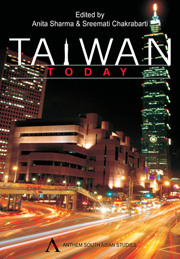Book contents
- Frontmatter
- Contents
- Acknowledgements
- Contributors to this Volume
- Acronyms and Abbreviations
- Foreword
- Introduction
- 1 Who are We? Identity in Transition
- 2 Taiwan: Yearning for an Identity
- 3 The Implications of Direct Flights: Beijing in Taiwanese Politics
- 4 Kuomintang, Democratization and the One-China Principle
- 5 The Deepening and Consolidation of Democracy in Taiwan
- 6 India and Taiwan: Bolstering Complementarity in Information Technology
- 7 Asian Regional Economic Integration and Taiwan–India Economic Relations
- 8 The Taiwan Factor in Sino–Indian Relations
- 9 Japan's Triumphant Diplomacy in Taiwan in 1874
- 10 A Study of the Cultural and Educational Exchanges between Taiwan and India, 1995–2006
- 11 Between Two Worlds: A Survey of Education in Taiwan
- 12 Female Immigrants, Social Capital and Public Sphere in Taiwan
- 13 Information Technology and Gender: Taiwan and India
- 14 Tzu Chi: A Case Study of Engaged Buddhism in Taiwan
- 15 Master Hsing Yun of Fo Guang Shan and the Development of Humanistic Buddhism
- 16 The Heritage and Innovation of Chan Paintings in Taiwan
- 17 Taiwan in World Architecture: A Historical Perspective
- Afterword
Afterword
Published online by Cambridge University Press: 05 March 2012
- Frontmatter
- Contents
- Acknowledgements
- Contributors to this Volume
- Acronyms and Abbreviations
- Foreword
- Introduction
- 1 Who are We? Identity in Transition
- 2 Taiwan: Yearning for an Identity
- 3 The Implications of Direct Flights: Beijing in Taiwanese Politics
- 4 Kuomintang, Democratization and the One-China Principle
- 5 The Deepening and Consolidation of Democracy in Taiwan
- 6 India and Taiwan: Bolstering Complementarity in Information Technology
- 7 Asian Regional Economic Integration and Taiwan–India Economic Relations
- 8 The Taiwan Factor in Sino–Indian Relations
- 9 Japan's Triumphant Diplomacy in Taiwan in 1874
- 10 A Study of the Cultural and Educational Exchanges between Taiwan and India, 1995–2006
- 11 Between Two Worlds: A Survey of Education in Taiwan
- 12 Female Immigrants, Social Capital and Public Sphere in Taiwan
- 13 Information Technology and Gender: Taiwan and India
- 14 Tzu Chi: A Case Study of Engaged Buddhism in Taiwan
- 15 Master Hsing Yun of Fo Guang Shan and the Development of Humanistic Buddhism
- 16 The Heritage and Innovation of Chan Paintings in Taiwan
- 17 Taiwan in World Architecture: A Historical Perspective
- Afterword
Summary
Taiwan is a fascinating story of the rise of some 23 million people populated over 36,000 sq. km. It has posed a hugely complex issue and situation. It is the fifth largest economy in Asia and has the third largest foreign exchange reserve. It can pride itself for possessing perhaps the largest computer hardware industry. In some ways it is a world player. Yet it is struggling with the question of identity. It would like to remain as it is but what that it is remains an open but most contentious issue. To me the fascinating part is not just its economic rise but its simultaneous bursting forth as a robust democracy, often noisy and chaotic.
Economic development began under authoritarian aegis and governmental guidance as Taiwan became one of the Asian tigers, but economic growth broke down the authoritarian structure. The spread of democracy within a highly developed economy surprised the world. Sometimes a single spark sets the prairie on fire, if I may borrow Mao's phrase in a different context. This spark in Taiwan was the Chungli incident in November 1977. The election of county magistrates and city mayors was taking place. There were widespread rumours of elections being rigged. The situation snapped in one of the counties – Taoyuan, I believe. Angry people in Chungli, encircled the police station and burnt it down. That became the catalyst for the dawn of democracy and from then on the democratic movement was on an unstoppable course.
- Type
- Chapter
- Information
- Taiwan Today , pp. 234 - 238Publisher: Anthem PressPrint publication year: 2010



